Are you finally ready to dip your toe into the world of cannabis tinctures? Or maybe you’ve seen a tincture work its magic firsthand, and now you are eager to make your own at home? If so, you’re in the right place! This beginner’s guide will cover the basics of all herbal tinctures so you can feel confident exploring the different types of medicine you can make at home.
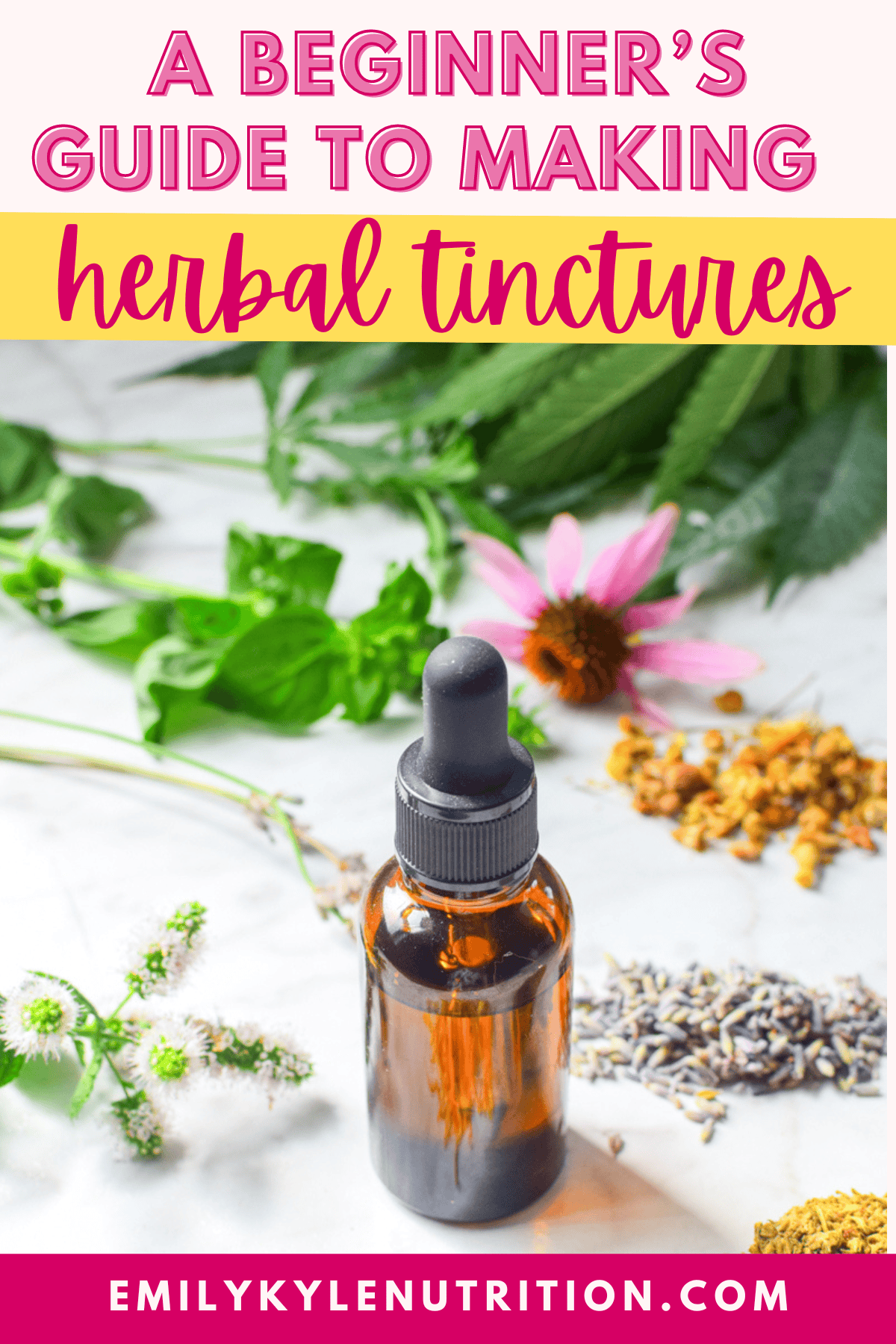
Table of Contents
- Article Features
- Why You Will Love This Guide
- What is a Tincture?
- Tincture Benefits
- What You’ll Need
- How to Make a Basic Herbal Tincture Recipe
- Storage Instructions
- How To Use A Tincture
- Herbal Tincture Recipes
- Echinacea Tincture
- Chamomile Tincture
- Lavender Tincture
- Calendula Tincture
- Rosemary Tincture
- Peppermint Tincture
- Lemon Balm Tincture
- Frequently Asked Questions
- Conclusion
- Related Posts
Article Features
- A basic introduction to the concept of tinctures
- Why its preferred and OK to use alcohol for the process
- Want to skip the hard work? Shop with me and have premium, high-quality cannabis products delivered directly to your door! Now shipping across the US.
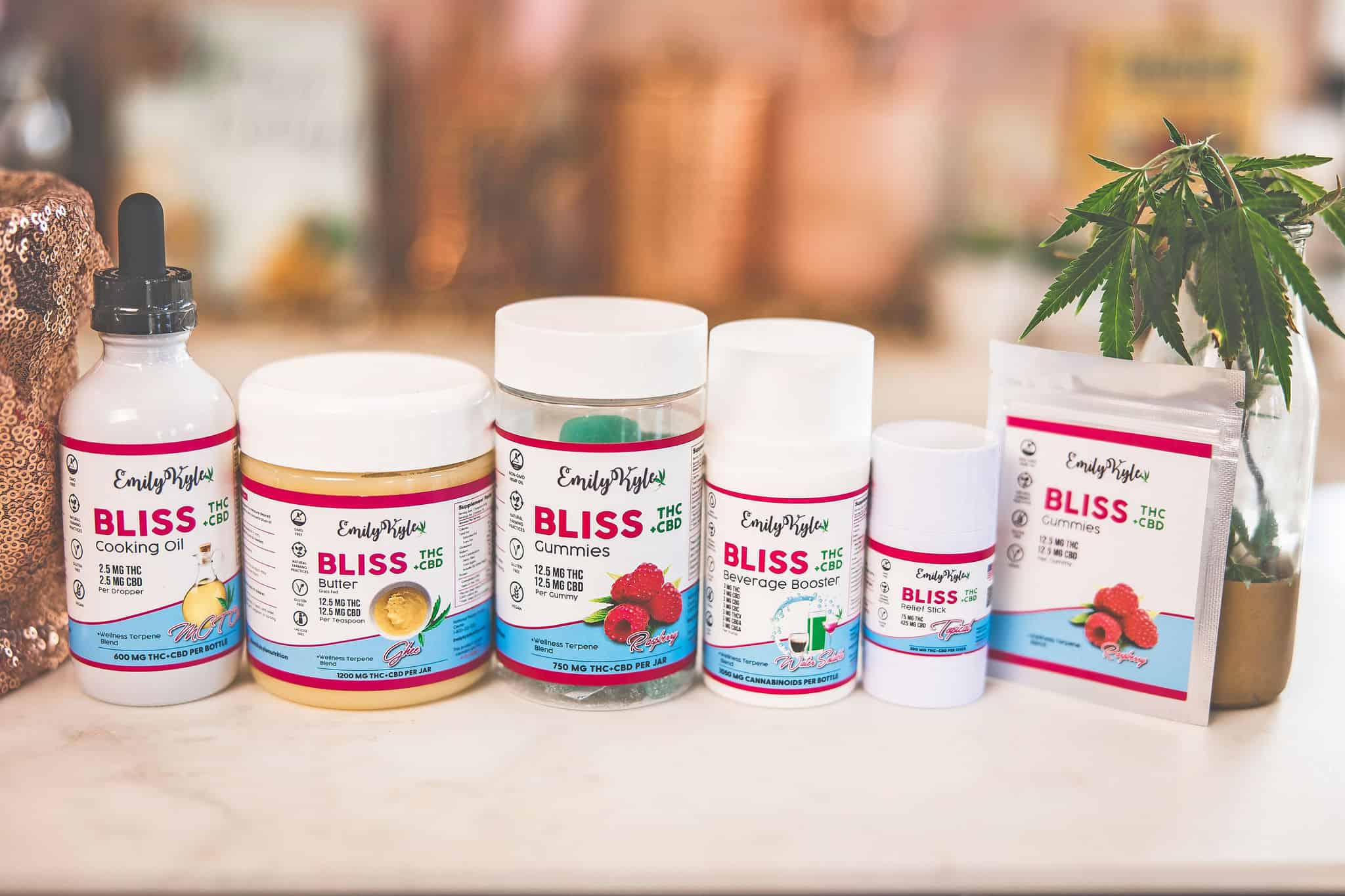
Why You Will Love This Guide
If you’re like me and other members of my Well With Cannabis Community, making a cannabis tincture was the first introduction to the world of tincture making.
In fact, I was so zoned in on the “cannabis” part that I didn’t even stop to understand the history and the significance behind the “tincture” part of the process.
I didn’t realize this was one of the most common ways to make herbal medicine up until the early 1900s or that this method can still be used today to easily make herbal tinctures at home.
I also didn’t realize that we all have a common modern-day form of tincture in our kitchen cabinets: vanilla extract.
As my understanding of the power of the cannabis plant has grown, so has my desire to learn more about other medicinal herbs.
In this guide, you will learn everything about making alcohol tinctures and herbal extracts at home, the benefits of tinctures, and my favorite herbal tincture recipes to get you started—cannabis and beyond.
What is a Tincture?
A tincture is a mixture of herbal material and a solvent, also called a menstruum.
Tinctures can be made with a variety of different solvents, including alcohol, vinegar, honey, or glycerine.
There are different names for all the different types of tinctures:
- Alcohol tincture = Extract
- Glycerine tincture = Glycerite
- Honey + vinegar tincture = Oxymel
The most common method for tincture making is to use alcohol to make an extract. Alcohol helps to capture and concentrate, or extract, the desired constituents of the herbs.
Constituents is the word used to describe the properties responsible for the medicinal action of plants.
Common active constituents include vitamins, minerals, flavonoids, cannabinoids, terpenes, and more.
Basically, by soaking your desired herbs in alcohol, you are creating an extract that contains the medicinal benefits of that herb.
The final product is an easy way to consume your chosen plant medicine in small doses.
If you do not like the thought of using alcohol, you can opt to make tea or an oil infusion instead.
Tincture Benefits
- Relatively easy to make
- Easily absorbed by the body
- Extract a wide range of constituents
- They are effective in small amounts because they are concentrated
- Can be very potent, so use caution when consuming
- The general dosage ranges from a few drops to 1 tablespoon
- Once prepared, different tinctures can easily be mixed together
What You’ll Need

The beauty of making your own tinctures at home is that you are in control of what and how much of each ingredient you put in.
In most cases, choosing home grown, locally sourced, or organic herbs is best.
This also means you control how strong you want your tincture to be.
Remember, the ratio of the herbs to liquid determines the strength of the tincture.
The more herbs you use, and the less liquid you use, the more portent your final product will be.
Fresh vs. Dried Herbs
It is your choice whether you want to use fresh or dried herbs for your tincture, as each herb has a different purpose and use.
Drying can be as simple as leaving your fresh herbs in a brown paper bag for a few days and allowing the plant to naturally wilt.
This process removes excess moisture from the plant material and helps to preserve the plant for long-term use or storage.
Once completely dry, the herbs can be stored in a glass container in a dark place.
Some plants, like St. John’s Wort, can be taken right from the herb garden and made into a tincture using fresh material.
Other plants, like cannabis, produce a better final outcome when a tincture is made with dried material.
It is important to note that dry herbs are more potent, or concentrated, than fresh plants, meaning you may be able to use less.
It’s also important to make sure you are working with the right parts of a plant, as different parts of the plant can serve different medicinal purposes.
For example, making a cannabis tincture with flower buds will have a much different (intoxicating) outcome than making a cannabis tincture with roots.

Remember:
Water is the enemy of most herbal preparations. It can cause mold, severely reduce the shelf life, and reduce the medicinal effect of the tincture.
How Much to Use
When it comes to preparing an herbal tincture, there are two ways to approach deciding how much to use.
The first approach is called the Folk Method. In this method, you simply add your desired amount of herbs to a jar and cover with alcohol – no measuring involved.
The second approach involves weighing the herbs and alcohol, or at least sticking to a ratio.
From the popular herbalism book, Illustrated Encyclopedia of Herbs, Rodale’s recommendation is to combine 4 ounces of powdered or finely cut herb with 1 pint of spirits in a glass jar with a tight-fitting lid.
In another herbalism book, Herbal Remedies Handbook, they recommend 1 part herb material to 3 parts water or alcohol in a 1:3 ratio.
When making a cannabis tincture, I recommend weighing the amount of cannabis in grams and then only using as much alcohol as needed to cover the surface area of the plant material.
As you progress on your herbalism journey, you will develop your own preferred methods of measurement with time and experimentation.
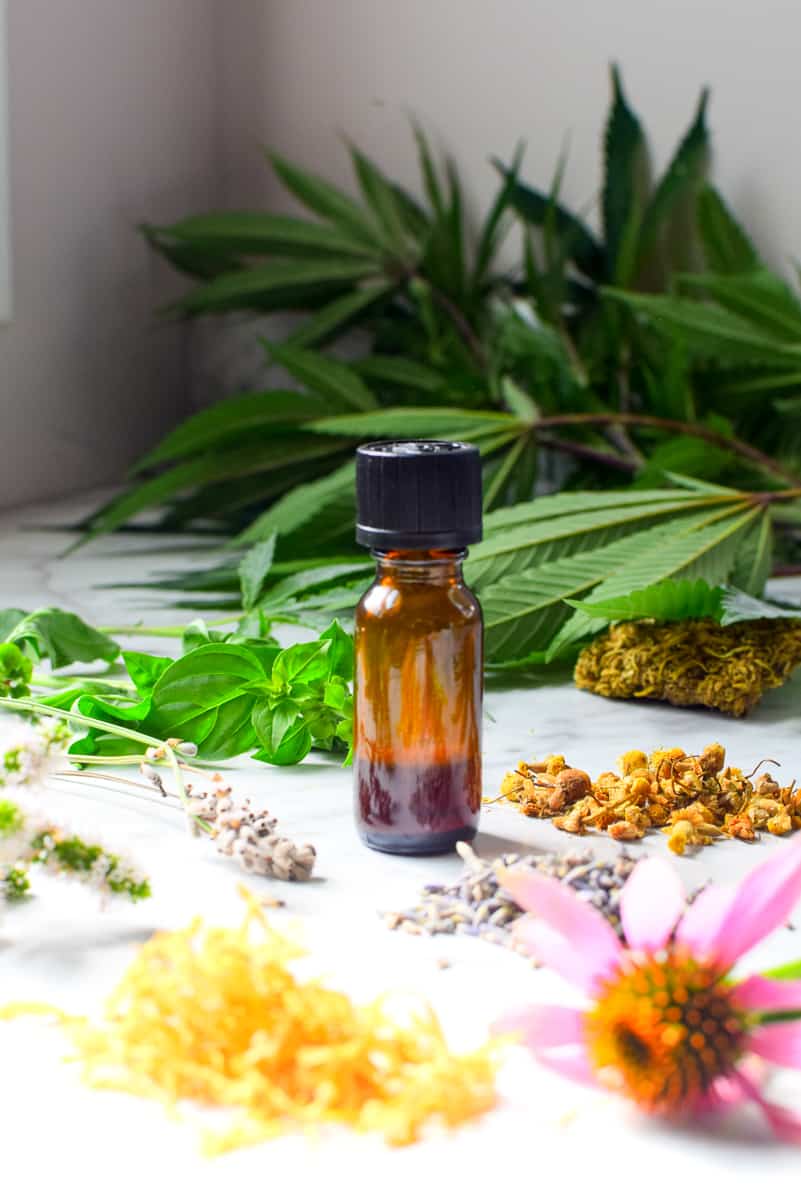
Alcohol
Using an alcohol base for your tincture is the most effective way to extract the active ingredients of the plant and preserve them for a long period of time.
The type of alcohol recommended will vary based on the herb you are working with and the constituents you wish to gain during the extraction process.
When shopping for alcohol, know that the alcohol content of a product can range from 25-90% alcohol, with the remainder being water content.
A more gentle alcohol, like 80-proof vodka, is suitable for delicate herbs like chamomile.
A more potent alcohol, like high-proof alcohol, is suitable for herbs like cannabis which contain cannabinoids to be extracted.
When shopping for alcohol:
- ALWAYS use food-grade alcohol like high proof ethyl alcohol, 151 rum, vodka, gin, brandy
- NEVER use rubbing alcohol or isopropyl alcohol, methyl alcohol or wood alcohol. These are toxic if ingested.
Learn where you can purchase high-proof alcohol here.
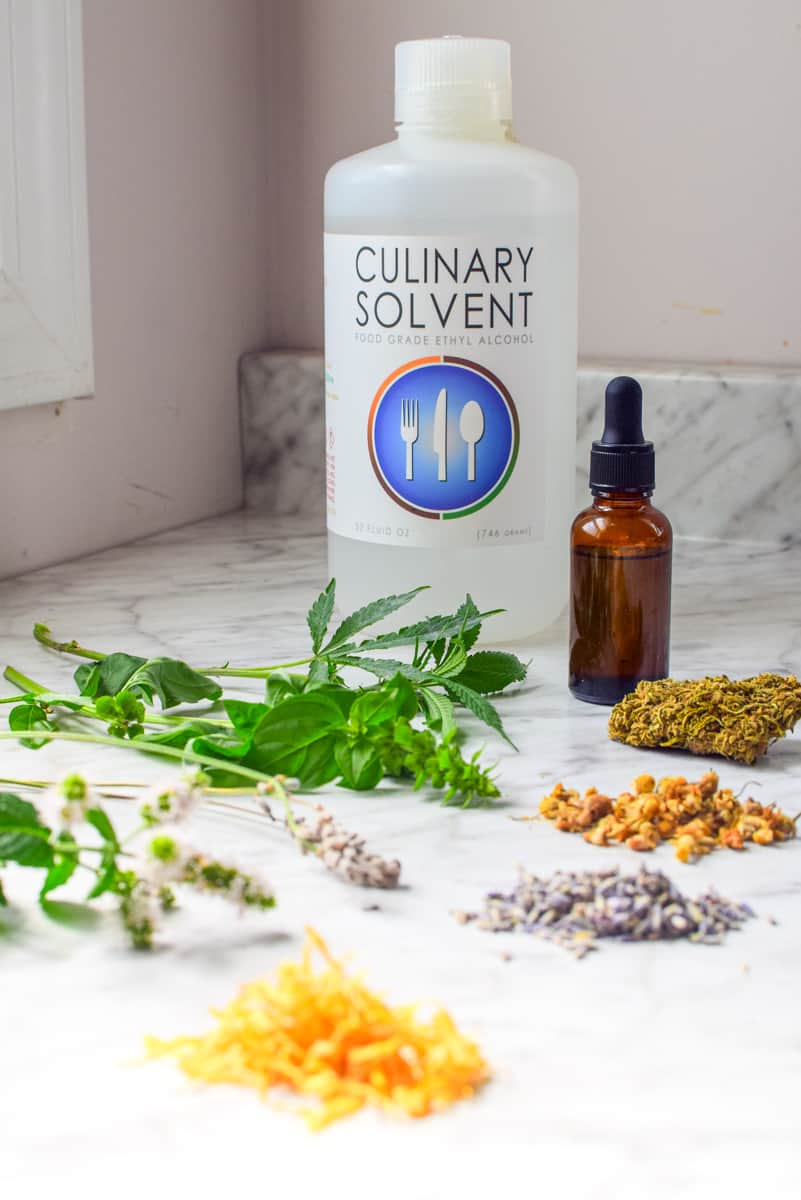
Helpful Tip:
Sometimes, a combination of both alcohol and water are used as the liquid base. This is to obtain both the water-soluble and non-water-soluble constituents. However, alcohol under 200-proof already contains water, so you do not need to add more.
Equipment
The beauty of making a tincture at home is that it is very simple and does not require any fancy equipment.
In fact, almost everything can be found at home or in your favorite local stores.
The following supplies are needed or helpful to make a tincture:
- Clean glass jar, like a mason jar, that has a metal lid
- Another glass jar that can be used for straining
- Straining supplies, like a fine mesh strainer, cheesecloth, or a coffee filter
- Storage containers, like these amber glass bottles
- If you want to get fancy, a small funnel can help
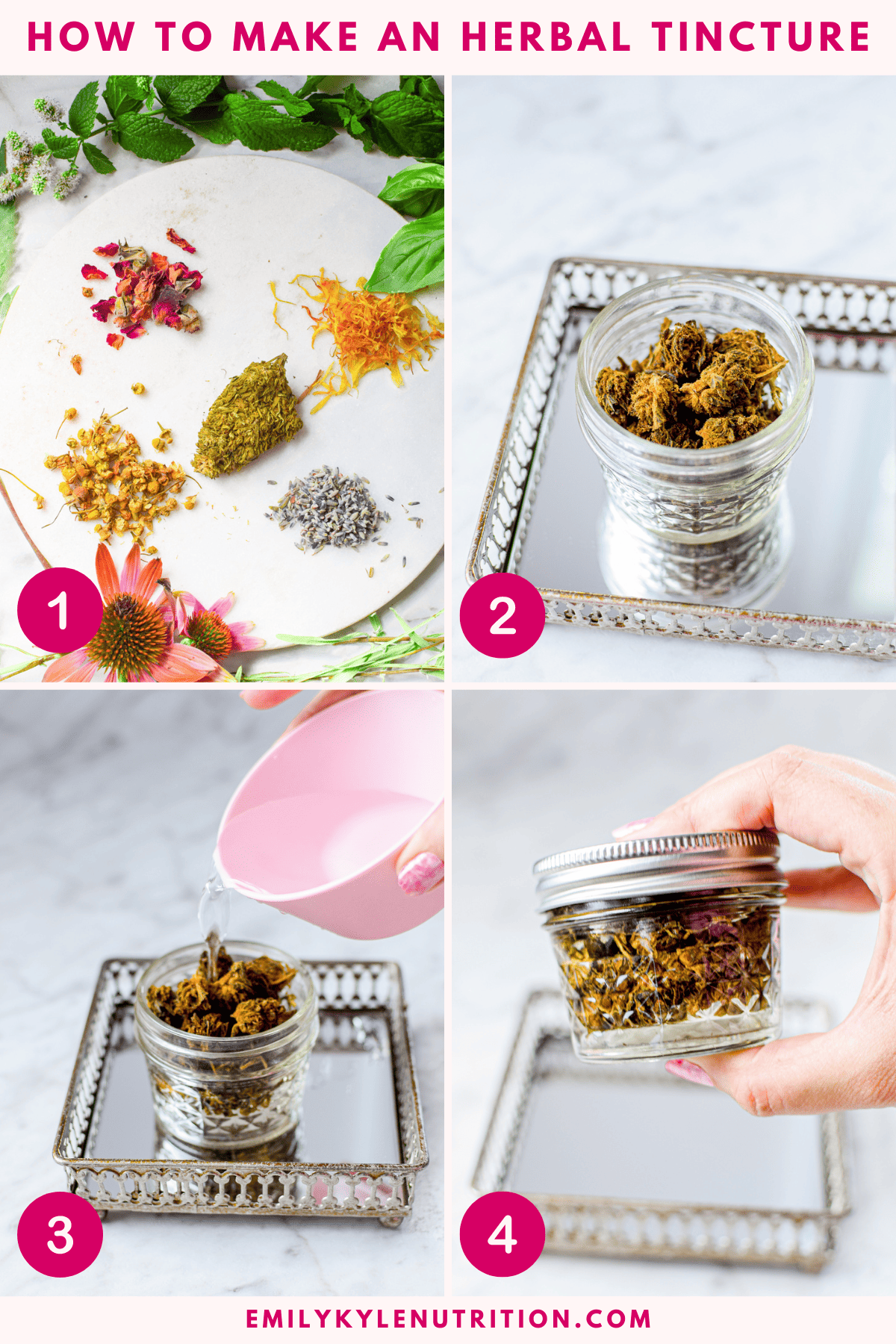
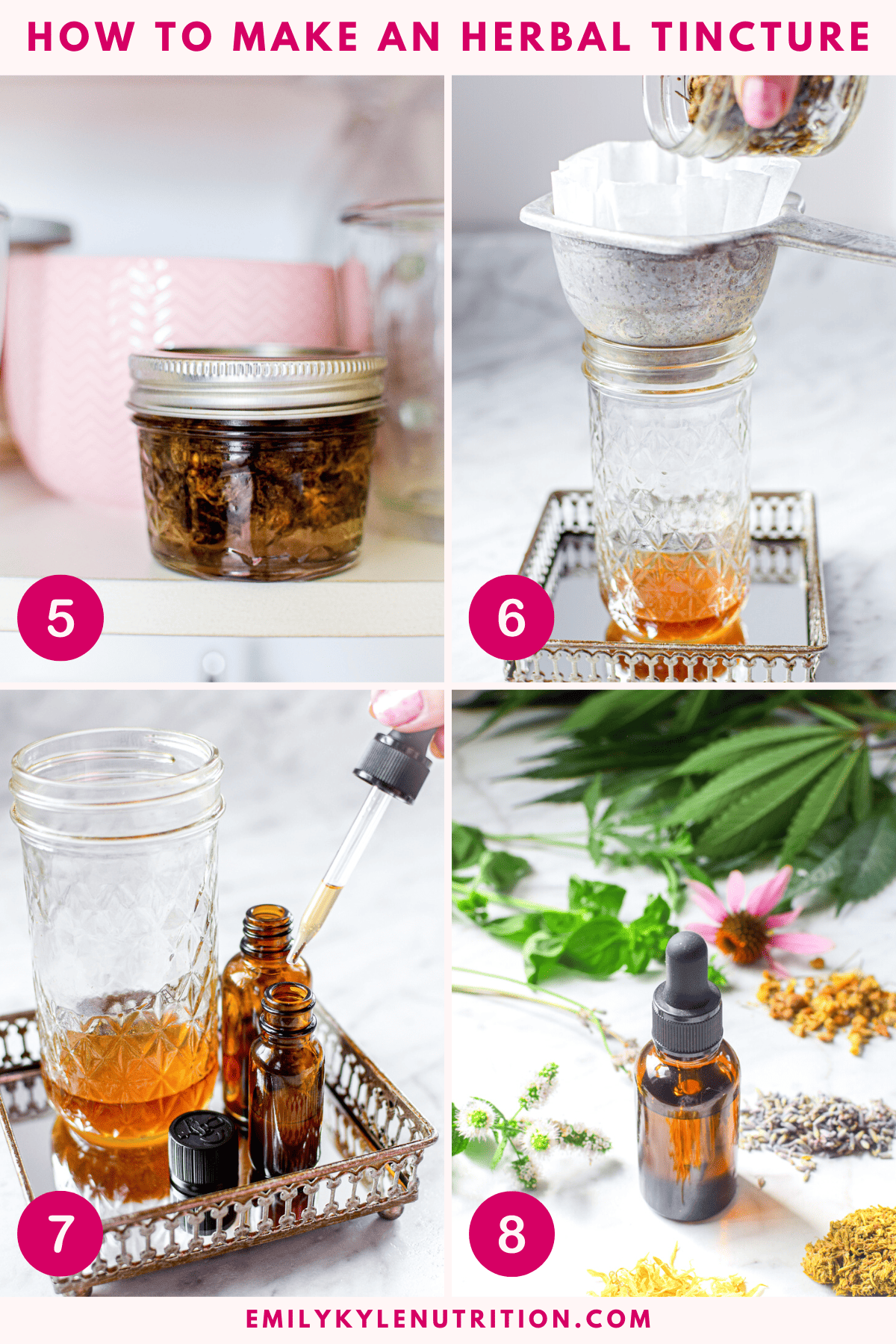
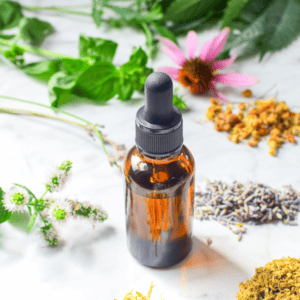
How to Make a Basic Herbal Tincture
What You Need
- ½ ounce dried herbs of choice
- 4 ounces alcohol of choice
Instructions
- If you haven't already, dry your herbs, unless you're following a recipe that specifically calls for fresh herbs. If you're choosing to measure ingredients, weigh out one ounce of dried herbs.
- Place the dried herbs in a pint-sized mason jar.
- Pour your desired amount of alcohol over the herbs. If you're following the Folk Method, you only need to add enough alcohol to completely cover the plant matter. Screw the lid on tightly and shake gently.
- Place the jar in a cool, dark location like a cupboard, and leave it to infuse for anywhere from 24-hours to 6 months. See notes for timing. Shake occasionally.
- After your tincture has been left to sit for your desired amount of time, it is time to separate the plant material from the infused alcohol. You can use a fine mesh strainer to strain off the alcohol into another clean jar.
- Alternatively, you could securely attach a piece of cheesecloth to the mouth of the jar and strain the liquid into a new, clean jar or tincture bottles.
- After straining, some people help the leftover plant matter to be re-used in other recipes, like homemade soap. Discover all of the ways to use the leftover plant material from a tincture here.
- You now have an herbal tincture. You can choose to evaporate off some or all of the alcohol now, if desired.
- It is recommended to move this tincture into a dark jar, if possible. Store your final tincture in a dark bottle in a cool, dark space.
Notes
Nutrition
Storage Instructions
It is best to store your finished tincture in a glass container in a cool, dry place.
Dark glass bottles are preferred because they block any light which may affect the potency of the tincture.
I love to use amber dropper bottles like this because they are dark and typically come with a measured dropper.
This makes it easier to dose homemade tinctures.
Property prepared tinctures have a long shelf life and can keep well for three years or more if stored properly.
Do your best to avoid heat, light, water and other contaminants.

How To Use A Tincture
Once prepared, a tincture can be used in various ways, from recipes and edibles to topical preparations.
The most common way to use a tincture is to place a few drops under the tongue for sublingual absorption.
You may need to evaporate some of the alcohol to make this a comfortable experience.
You can also add a few drops of a tincture to your favorite drink or recipe.
This is a great way to reap the plant medicine without any discomfort.
Learn more about how to use a marijuana tincture here.
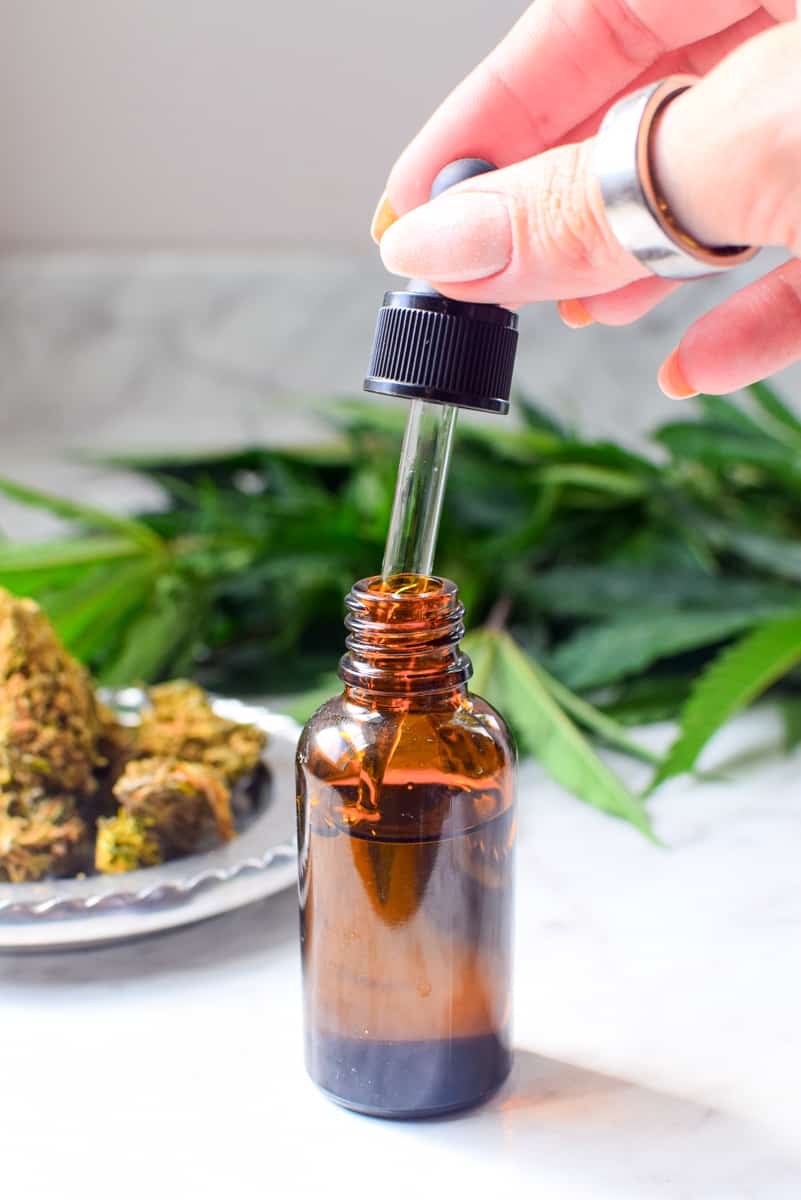
Herbal Tincture Recipes
Cannabis Infusions & Extractions
Easy Green Dragon Recipe » Cannabis Alcohol Tincture
Cannabis Infusions & Extractions
Golden Dragon QWET Cannabis Freezer Tincture
Cannabis Infusions & Extractions
Cannabis Roots: Benefits, Uses & Tincture Recipe
Cannabis Infusions & Extractions
How to Make a THCA Tincture
Cannabis Infusions & Extractions
How to Make a CBDA Tincture
Echinacea Tincture
Echinacea, one of the most popular medicinal herbs, affects the body’s immune system.
An echinacea root tincture is often used at the onset of minor illnesses, such as the common cold, to prevent or shorten the duration of the illness.
An echinacea tincture is also used as a sore throat spray.
Chamomile Tincture
Chamomile is a traditional remedy for sleeplessness and headaches, and is often used to relieve stress.
Chamomile tincture is also used to lessen pain, including the pain of menstrual cramps and headaches.
Lavender Tincture
Like chamomile, lavender is a natural stress-reliever that is used to relieve and enhance feelings of well-being.
Lavender promotes restful sleep and promotes relaxation during times of stress.
Calendula Tincture
Calendula tincture is applied topically to minor cuts and scrapes to promote fast healing.
The tincture can be applied directly to the wound, or added to a cream-based salve.
Rosemary Tincture
Rosemary tincture contains antioxidants and helps reduce inflammation in the body.
Used internally, rosemary helps eliminate free radicals, reduces restlessness and promotes restful sleep.
Rosemary tincture also reduces the pain and inflammation associated with arthritis.
Peppermint Tincture
Peppermint tincture is a useful addition to the medicine cabinet, as the herb is used to treat indigestion and other common stomach ailments.
Peppermint tincture is also applied topically to treat mild headaches, and relieves minor muscle aches when applied topically.
Lemon Balm Tincture
Traditionally, lemon balm tincture is used to treat depression, and is thought to relieve stress and enhance feelings of well-being.
Lemon balm is an antiviral that is used to treat viral infections, including cold sores, and to treat the flu and other viral illnesses.
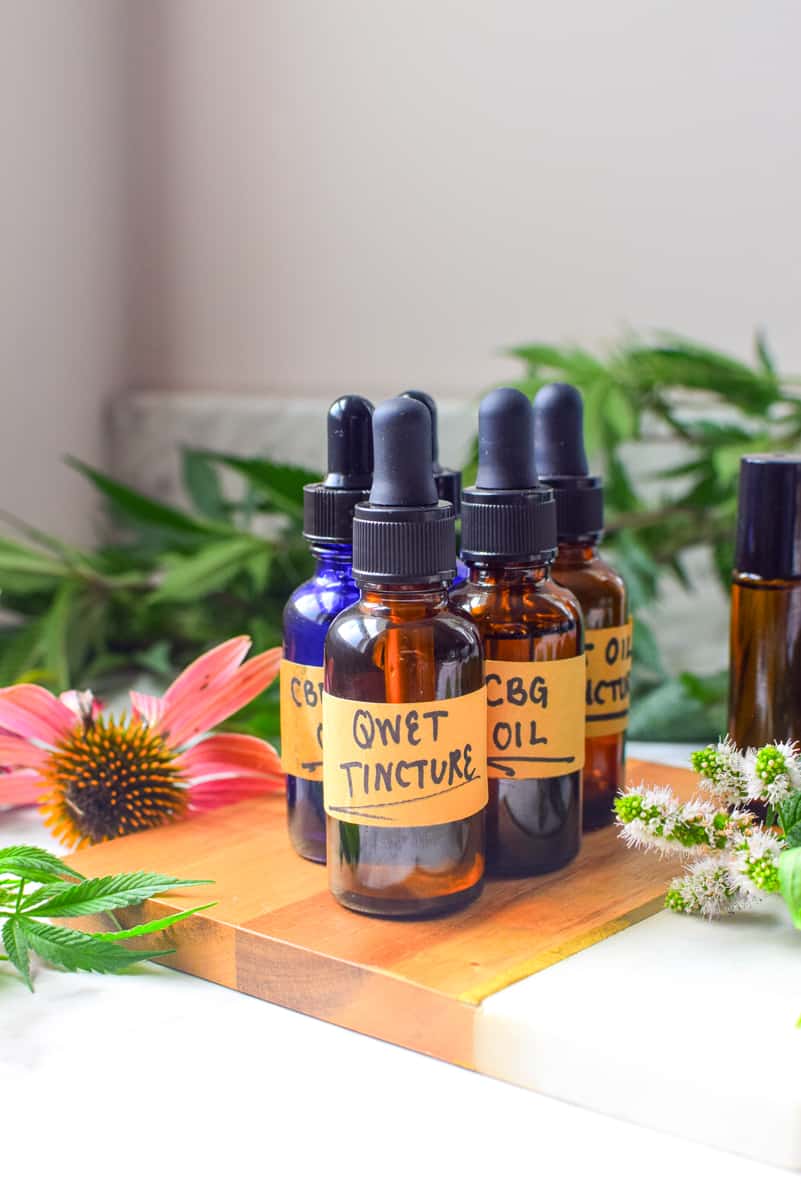
Frequently Asked Questions
This is a great question and perfectly understandable. If you cannot have alcohol, know that there are many other types of herbal remedy preparations. From herbal tea to essential oils to oil infusions, there are certainly other ways to capture the medicinal properties of different herbs without the use of alcohol.
I have not tried this myself, but simply swap your choice of vinegar, like white vinegar or apple cider vinegar, or glycerine in place of alcohol.
As always, please consult your doctor or other qualified medical professional. For the purpose of this guide, we are only recommending herbal tinctures for oral use.
One concern many people have when using alcohol-based tinctures is how the alcohol will affect them. If you are using just a very small amount, it is unlikely you will feel the effect or experience and adverse reactions from consuming the alcohol. Think of using vanilla extract, just a few drops is enough to use, without consuming too much.
We totally understand, the burn is unplesant to say the least. Even a little bit under the tongue can be uncomfortable. We have several different ways you can reduce the amount of alcohol from a tincture outlined here. One of the easiest ways to dilute your tincture is to place a few drops in a cup of hot water or tea. The warm water liquid will naturally evaporate the alcohol.
Conclusion
That’s it – everything you need to know about making the best tincture at home!
Taking the time to make your own herbal tinctures is a great way to preserve the medicinal qualities of specific herbs and begin to create your own medicinal apothecary at home.
I hope this guide leaves you filled with positive energy and excitement to go out and create.
Remember, there is no one best way to make a tincture or make your own medicine, so be patient, keep experimenting, and do what works best for you!
Have you ever made your own herbal tinctures at home? What do you like to keep on hand? Let me know in the comments below!
Related Posts
Holistic Health
Meet Kratom » A Plant You Should Know
Holistic Health
7 Plants That Thrive in a Bathroom + How to Hang Them
Articles & How-To Guides
9 Benefits of Cannabis For A Healthy, Holistic Lifestyle
Holistic Health

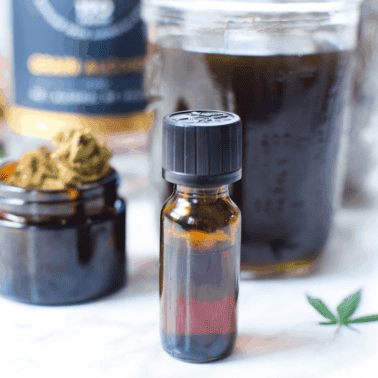
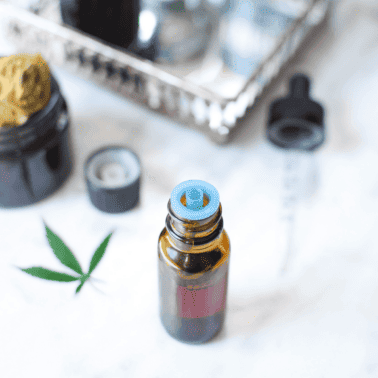

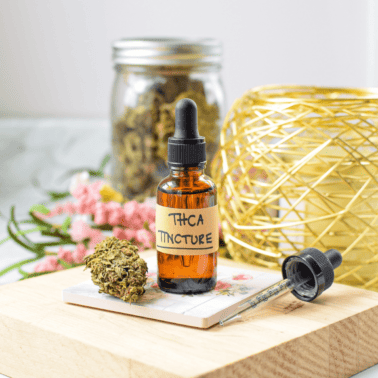
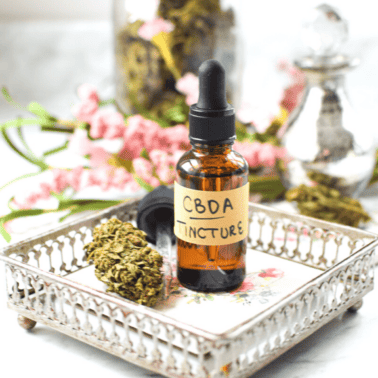
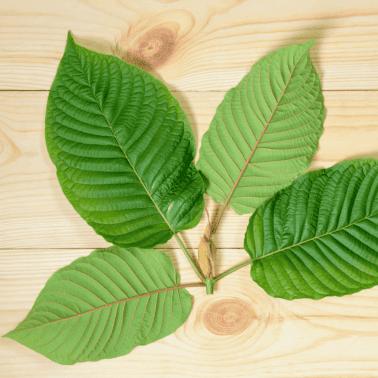

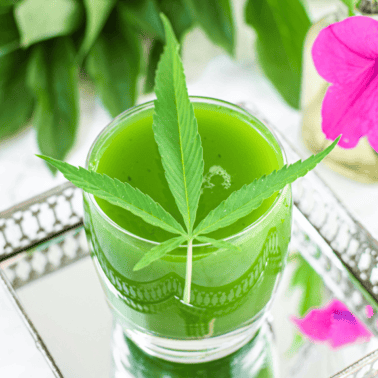
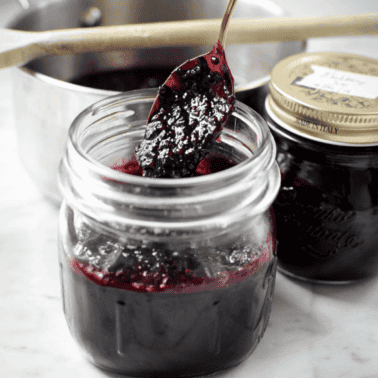








Does carboloizing for longer weaken the potency?
Hi Ed. It doesn’t necessarily weaken the potency, but will cause the cannabinoids to continue to convert eventually degrading over extended amounts of time. THC will convert to CBN, causing sleepier effects. I hope this helps!
Just made this today, burned/evaporated off half of content. Still has a little sting from moonshine used in process. Im not fond of oil tinctures. I had made elderberry tincture before which is alcohol based as well. Going to try it as a tincture but may incorporate into gummies
Hi Natalie. Thank you for sharing your experience with us. Incorporating the elderberry tincture into gummies sounds like a creative idea! Best of luck with that and I hope you enjoy the final result! Let us know how they turn out!
Hi Emily,
Thankyou for all the information about Cannabis.
It is a very interesting plant indeed.
When you make Feco, can you include something like mint to help make it taste nicer?
When you cook edibles, wouldn’t the cooking process degrade the THC, CBD, CBG.
Thankyou.
Debbie.
Hi Debbie. Cannabis is indeed a fascinating plant with so much to explore. Adding mint to FECO will improve its taste, yes, so you can definitely add mint or other natural flavorings. These flavorings can help mask the strong taste of the cannabis oil, making it more palatable.
As for your concern about cooking with cannabinoids like THC, CBD, and CBG, this is a great question! I like to think of it like this:
It’s kind of like when you roast a chicken. You put it in the oven at 350° for 1-2 hours, but the chicken itself only ever needs to get to the internal temp of 165° until it’s done. When baking, the item itself should not get to 350° because it would burn up. You don’t want or need to get up to 350°, you just want the item cooked through or to 165.
Does that make sense?
I hope this answers your questions, Debbie! Feel free to reach out if you have more questions.
Does it have to be drinking alcohol
Hi Amanda. It’s important to ALWAYS use food-grade alcohol like high proof ethyl alcohol, 151 rum, vodka, gin, brandy.
NEVER use rubbing alcohol or isopropyl alcohol, methyl alcohol or wood alcohol. These are toxic if ingested.
I hope this clarifies things for you 🙂